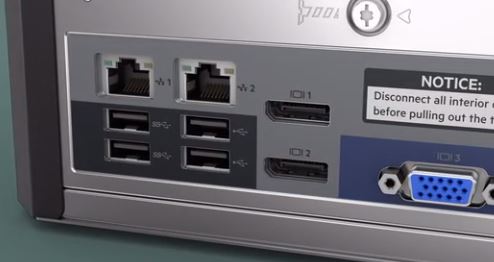AMD Opteron X3421 Market Positioning
Thes chips are not released in a vacuum instead, they have competition on both the Intel and AMD sides. When you purchase a server and select a CPU, it is important to see the value of a platform versus its competitors.
AMD Opteron X3421 v. AMD Alternatives
The AMD Opteron X3421 is an APU. We think that dual-core systems may be “good enough” for 1-4 bay NAS applications or extremely light services, but that is about it. Our pick, given what we saw performance wise, would be the AMD Opteron X3421. There are a few caveats in the AMD stack now.
As an APU, the AMD Opteron X3421 has an integrated GPU. That can be useful for applications like digital signage or video transcoding. The HPE ProLiant Microserver Gen10 has dual DisplayPort outputs capable of 4K resolution just for this case. Running a small server that costs under $500 to loop video to two displays in a retail location or dashboards for teams is something we know customers will respond to. Likewise, it can serve as displaying a team dashboard while being the local cache or backup NAS device in an office. The niche makes sense.

With the launch of the AMD EPYC Embedded 3000 series, AMD has a compelling offering in this space. If you wanted to have a microserver with multiple SFP+ 10GbE connectivity, more PCIe lanes, more performance, and more memory support, the AMD EPYC 3000 series would be the go-to option. That change would also likely require the addition of a BMC chip, ROM chip, and RAM chip to provide video output to the device since the EPYC 3000 series lacks a GPU. Frankly, we would love to see this as the AMD EPYC Embedded 3251 was an awesome performer.
AMD Opteron X3421 v. Intel Alternatives
Overall, we found the AMD Opteron X3421 to be intriguing compared to the Intel lineup. It occupies a place where Intel does not have a direct competitor. The Intel Atom C2000 series is clearly behind in performance. Newer Denverton Intel Atom C3000 series chips are more competitive, but core-for-core the AMD Opteron X3421 is able to notch wins. One gives up 10GbE with the AMD Opteron X3421, as well as the potential for more high-speed I/O.
Moving up to the newer Intel Xeon E-2100 CPUs one can get significantly more performance and iGPUs, but realistically the faster, yet higher TDP Intel Core i3-8100 is closer in price and a better competitor with much higher performance.
Given the TDP range, the performance, price, and feature set, the AMD Opteron X3421 occupies a unique niche in the market where Intel does not have a direct competitor. If one is willing to trade-off in one area, e.g. pay more, or have a higher TDP design, Intel can offer more performance, but sticking to 35W TDP, the AMD Opteron X3421, which is going to essentially be found in the HPE ProLiant Microserver Gen10, is a solid option.
AMD Opteron X3421 v. Arm Alternatives
Most CPUs in the 35W TDP range for servers on the Arm side will have built-in 10GbE. There is still a large advantage to having an x86 CPU at the time of this writing. Arm is closing the gap, but there are plenty of organizations that are not ready to bring Arm CPUs into this class of device. That may or will change in the future depending on your point of view. There are Arm alternatives out there. We have seen them in competitive products such as with our Asustor AS4004T Review: A Fast and Affordable 10GbE 4-Bay NAS. This is something that AMD and HPE will have to contend with in future iterations.
Final Words
Our longtime readers may notice we talked a bit about power consumption but did not provide exact figures. Since most of our readers will only see this APU in the HPE ProLiant Microserver Gen10, and that review is scheduled to go live this quarter with testing already compete, we are going to instead publish power consumption in that context.
From our readers, we have heard a few viewpoints that the AMD Opteron X3421 is not fast enough. Given this is a lower-cost, and lower TDP, processor, that is to be expected. Even using an older process node, AMD is able to get plenty of performance for a NAS and basic network services and applications.
In a 4-bay NAS or small server environment, the AMD Opteron X3421 is plenty. In a future revision, we would love to see 10GbE and potentially a few more PCIe lanes. If the HPE ProLiant Microserver Gen10 had even three or four more usable PCIe lanes and 10GbE onboard it would be an absolutely killer platform with the AMD Opteron X3421 APU performance. Our review of that system is coming, however, we found the APU performance to be better than we expected when we started this project which is a good sign for AMD.




I mean, if you need more computing power you will want more RAM and 2 slots isn’t enough.
We’ve got 7 microservers with these for a K8s cluster. You’re right they need more PCIe and 10gb networking. I’d never get the dual core.
The Gen8 was a better server. The suggestion of the EPYC 3000 in a Microserver with 10G and more PCIe will keep me from sleeping tonight. Thanks a lot STH!
This would be a nice CPU for use as a pfsense router. Would be nice if it has the 10Gbe right away though.
Was hoping to get data about noise and wattage:(
I like this CPU and there’s no alternative from the competitor. You can get very decent performance, with graphics and nice virtualization at very low wattage. Only glitch on the gen10 microserver is the fan plug. The highest current Opteron is the choice for 10gbit solution. Forget gen8.